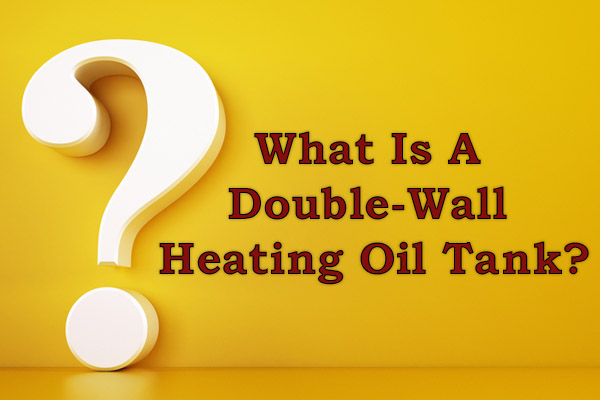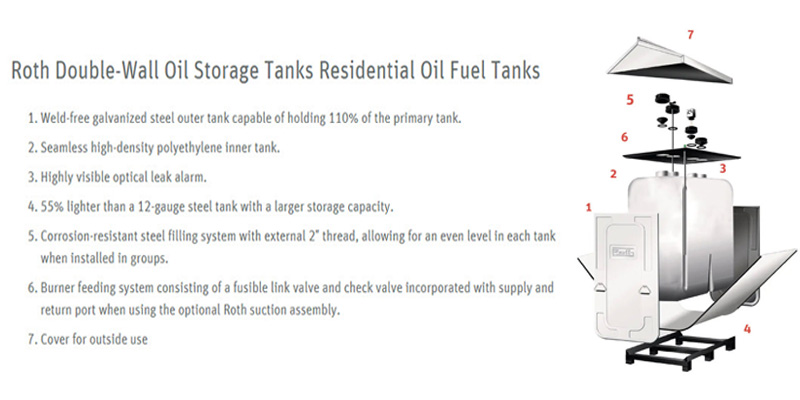What Is A Double-Wall Heating Oil Tank?

Heating oil is a prevalent fuel source for households in the eastern U.S. Typically stored in an on-site tank, this oil is channeled to the home’s furnace or boiler to generate warmth. When homeowners think about upgrading their current oil storage, the double-wall heating oil tank stands out as a viable choice. In the ensuing passages, we’ll delve into the double-wall tank’s design, its merits, and the reasons it’s gaining traction among homeowners.
Related Article: The Best Ways To Prevent Running Out Of Heating Fuel This Winter
Understanding the Double-Wall Heating Oil Tank
Characterized by its unique dual-layer design, the double-wall heating oil tank consists of a primary internal tank enclosed by a secondary exterior tank. The gap between these tanks, known as the interstitial space, acts as a protective shield, deterring leaks or potential spills from the inner tank from contaminating the surroundings.
Equipped with a secure and vigilant leak detection system, the interstitial space comes fitted with sensors and alarms. These mechanisms are designed to promptly alert homeowners to any discrepancies. If there’s any leakage, this compartment is structured to confine the spill, ensuring it doesn’t harm the environment.
Adding another layer of safety, these double-wall tanks incorporate a feature known as the “spill bucket.” Nestled within the interstitial space, this compact receptacle is designed to capture any incidental leaks or spills, further safeguarding against potential environmental hazards.
Related Article: What Size Oil Tank Do I Need For My Home?
Understanding the Mechanism of a Double-Wall Heating Oil Tank

The primary compartment of this tank, known as the inner tank, serves as the storage area for the fuel. Surrounding it is the outer tank, which functions as a backup containment shield. Should there be any leaks or spills from the inner vessel, the interstitial zone between these two tanks ensures the fuel is trapped, preventing it from leaking into and potentially harming the environment.
Advantages of Opting for a Double-Wall Heating Oil Tank
Choosing a double-wall heating oil tank comes with a myriad of perks as compared to its single-wall counterpart. Foremost, it offers enhanced protection from inadvertent leaks and spills. This supplementary containment feature in the double-wall design ensures an extra layer of security, something a single-wall model doesn’t offer.
Furthermore, double-wall heating oil tanks are designed to last. Often, the external layer is crafted from high-density polyethylene (HDPE), a sturdy material known for its resistance to UV rays and its ability to endure harsh weather elements. This makes the double-wall design especially apt for outdoor placements.
Related Article: Roth Vs. Granby Oil Tanks: What To Consider
Double-Wall Heating Oil Tank: Your Questions Answered
Keep reading to explore FAQs on double-wall home heating oil tanks.
Do Double-Wall Heating Oil Tanks Cost More Than Single-Wall Tanks?
Yes, double-wall heating oil tanks generally have a higher price tag than their single-wall counterparts. Several factors contribute to this:
- Materials: While the inner tank is crafted from the same materials as single-wall tanks, the outer tank uses high-density polyethylene (HDPE), a pricier alternative to the steel or standard plastic found in single-wall tanks.
- Manufacturing Complexity: Creating a double-wall tank involves a two-step process: producing the inner and outer tanks separately and then uniting them. Ensuring the gap between the tanks is leak-proof adds further to the production costs.
- Installation: Installing double-wall tanks can be a bit more intricate. They must be precisely leveled, and consistent monitoring is essential to catch any potential leaks in the interstitial space.
- Long-Term Investment: While the initial outlay for a double-wall tank might be steeper, its durability could lead to long-term savings, negating frequent repairs or replacements.
Can I Position a Double-Wall Heating Oil Tank Inside My Home?
Absolutely, double-wall heating oil tanks can be situated indoors, but there are a few points to bear in mind:
- Ventilation: Always ensure the tank’s location is well-aerated to thwart the accumulation of hazardous fumes. Utilizing a vent pipe to redirect any fumes outdoors can be an effective measure.
- Safety Precautions: Adhering to the manufacturer’s guidelines and local building codes is essential. Installing additional protective equipment, like a spill containment tray, can be a prudent step to manage any unexpected leaks or overflows.
- Expert Consultation: Given the nuances involved, it’s advisable to liaise with a specialist familiar with heating oil tank installations. Their expertise can be invaluable, guaranteeing that the setup is safe, efficient, and compliant with all local stipulations.
Related Article: How Much Heating Oil Will I Use A Day?
Is it Mandatory by Law to Have Double-Wall Heating Oil Tanks?
The stipulations concerning the use of double-wall heating oil tanks are not uniform across the board; they differ depending on state and even local administrative rules. While it’s not universally mandated, several states do emphasize the need for a secondary containment system for fuel storage tanks.
Some jurisdictions dictate that newly installed tanks should adhere to the double-wall design. Meanwhile, in other regions, this provision might only be relevant when an old tank is being replaced. Moreover, there’s also the possibility of certain legislations necessitating that prevailing single-wall tanks be upgraded—either by switching to a double-wall setup or by introducing an additional containment tray.
To steer clear of potential legal pitfalls, it’s advisable to touch base with either your local governmental body or an expert well-versed in the regulations specific to your locale. This will ensure not only legal compliance but also optimized safety standards.
In Summary
The double-wall heating oil tank stands out for its dual-layer protection, guarding against any unforeseen leaks or spills. Its reinforced design lends greater longevity and an extra safeguarding layer. Although the initial cost is higher than single-wall tanks, the extended durability and enhanced security could make it a financially sound decision over time.
Related Article: Should My Furnace Smell Like Heating Oil?
Call Van Varick & Sons For All Your Home Heating Needs
For all your HVAC and oil delivery needs, contact Van Varick & Sons. We have some of the most highly qualified and professionally certified technicians in Northern New Jersey. Each of our friendly techs can conduct a variety of HVAC services, such as oil tank upgrades, boiler maintenance, ductless installations, furnace replacements, air conditioner repairs and more.
We have various oil delivery plans and financing options. This way, you can customize your fuel deliveries to meet your needs. Our heating oil delivery and HVAC services are affordable and are done accurately and promptly at all times.

All of our services come with a guarantee. Our HVAC maintenance services improve your energy efficiency and home comfort while decreasing your HVAC costs. We can also assist you when you need to replace your heating and cooling system. We will help you find the best make and model for your home without sacrificing your budget. Our experts have the skills, training, and experience to ensure that all your home comfort needs are met. Book an appointment with us today. Call Van Varick & Sons for a free, in-home estimate.
You can click here to contact us now or call us at (973) 694-2777 to find out more! Click the link to view our service area.
